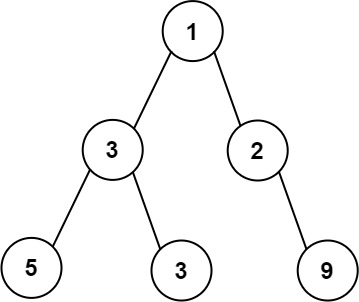Problem
Given the root of a binary tree, return the maximum width of the given tree.
The maximum width of a tree is the maximum width among all levels.
The width of one level is defined as the length between the end-nodes (the leftmost and rightmost non-null nodes), where the null nodes between the end-nodes are also counted into the length calculation.
It is guaranteed that the answer will in the range of 32-bit signed integer.
Example 1:

1 | Input: root = [1,3,2,5,3,null,9] |
Example 2:

1 | Input: root = [1,3,null,5,3] |
Example 3:

1 | Input: root = [1,3,2,5] |
Constraints:
- The number of nodes in the tree is in the range
[1, 3000]. -100 <= Node.val <= 100
Analysis
题目意思很简单,给出一颗二叉树,要求求出树的宽度。首先这里要明确什么是宽度,我一开始的做法是BFS,根节点的坐标为0,左节点-1,右节点+1,但是这样算出来的并不是最大宽度,因为它只计算了相对于根节点的位置,并不能计算出坐标重复的情况,所以更好的做法应该是采用满二叉树的下标计算方法,即假设根节点的下标为i,其左子节点的下标为2 * i,右子节点的下标为2 * i + 1,BFS时只需要把每层最右的下标减去最左的下标+1就是该层的宽度。
Solution
这道题目还有一个越界的坑,当我们使用满二叉树下标计算方法,当树的层数很深时,就算节点很少,也会造成int越界,这里的解决方法也很巧妙,因为层与层的计算是独立的,而且我们只关心一个差值,至于这个下标实际是多少我们并不care,所以每层计算完之后,我们都做一个归零处理。
比如第i层的第一个节点下标是x,那么处理这层所有的下标减去x,这样就能防止下标越界了。
Code
1 | /** |
Summary
这道题目是二叉树中一道比较有意思的题目,其中对于越界情况的处理比较值得总结。这道题目的分享到这里,感谢你的支持!

